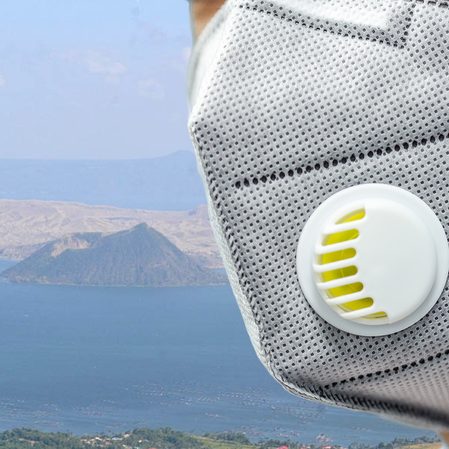SUMMARY
This is AI generated summarization, which may have errors. For context, always refer to the full article.

Taal Volcano emitted a record-high amount of sulfur dioxide (SO2), averaging at 14,326 tons per day, on June 28.
According to the Philippine Institute of Volcanology and Seismology (Phivolcs), the high levels of SO2, along with water vapor emitted in plumes, weak air movement, and solar radiation resulted in the volcanic smog or vog observed over the volcano.
As of Wednesday, June 30, the vog has reached Calabarzon, Metro Manila, and other parts of Luzon.
Phivolcs has advised local government units in areas surrounding the volcano to conduct health checks on affected communities and to consider temporary evacuation of severely exposed residents, among other safety measures.
Here’s what you need to know about sulfur dioxide and how it can affect one’s health.
What is sulfur dioxide?
Sulfur dioxide or SO2 is a heavy, colorless, and poisonous gas. The Air Quality Management Section of the Department of Environment and Natural Resources says it is one of the major air pollutants monitored in the country. It is odorless at low concentrations, but it can have a “very strong smell” at high concentrations.
According to the World Health Organization (WHO), SO2 is produced from burning fossil fuel (coal and oil) and the smelting of mineral ores containing sulfur.
What are the sources of sulfur dioxide?
The 2005 air quality guidelines by the WHO say natural sources, including volcanoes, contribute to “environmental levels” of SO2.
Meanwhile, man-made contributions include the use of sulfur-containing fossil fuels, used in domestic heating, stationary power generation, and motor vehicles. High-sulfur coal is also used for power production.
What are the health effects of sulfur dioxide on humans?
SO2 affects the respiratory system and lung function. Phivolcs, the WHO, the US National Park Service, and the American Lung Association, citing the United States Environmental Protection Agency (EPA), list multiple effects of SO2:
- Irritation of the eyes, skin, nose, throat, and respiratory tract
- Inflammation of the respiratory tract, which causes coughing, mucus secretion, aggravation of asthma, and chronic bronchitis, and causes people to be more prone to respiratory tract infections
- Wheezing, shortness of breath, chest tightness, and other problems, especially during physical activity
- Reduction of the ability of lungs to function and increase of respiratory symptoms with continued exposure at high levels
- For people with asthma, short exposures to peak levels of SO2 in the air may cause breathing difficulties when they are active outdoors
As SO2 is highly soluble, it is readily absorbed in the upper respiratory tract, and its effects are enhanced if it penetrates lower regions through breathing through the mouth instead of the nose, and through exercise.
Who is most vulnerable to these effects?
In terms of short-term exposures and their effects on pulmonary function, the WHO notes that there is a spectrum of sensitivity to SO2. Some people may be unaffected by a concentration that would cause severe bronchoconstriction in others.
The following are more sensitive to the effects of SO2 exposure:
- People with asthma
- People with lung diseases, including chronic bronchitis and emphysema
- People with heart disease
- The elderly
- Pregnant women
- Children
Children, older adults, and people with asthma are at increased risk of hospital admissions or emergency room visits.
How long does it take to feel the effects?
The WHO says the response to inhaled SO2 is “rapid,” with the maximum effect usually reached within a few minutes.
It adds that continued exposure does not generally increase the response, “and there is a tendency for it to decline gradually.”
In controlled studies with exercising asthmatics, it was indicated that some experienced changes in pulmonary function and respiratory symptoms within exposure periods as short as 10 minutes.
How long do the effects last?
Depending on the individual and the severity, lung function may return to normal within minutes to hours.
Phivolcs advises people to avoid outdoor activities, stay indoors and close doors and windows, cover one’s nose, drink plenty of water to reduce throat irritation or constriction, and to seek medical help if needed. – Rappler.com
Add a comment
How does this make you feel?

There are no comments yet. Add your comment to start the conversation.